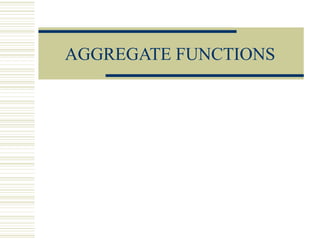
MYSQL Aggregate Functions
- 2. Aggregate Functions What is an aggregate function? An aggregate function summarizes the results of an expression over a number of rows, returning a single value. The general syntax for most of the aggregate functions is as follows: aggregate_function ([DISTINCT|ALL] expression)
- 3. Commonly used Aggregate functions Some of the commonly used aggregate functions are : • SUM • COUNT • AVG • MIN • MAX
- 4. Examples Consider the following Employee table: EMPLOYEE ( EMP_ID, NAME, DEPT_NAME, SALARY) CREATE TABLE EMPLOYEE ( EMP_ID NUMBER, NAME VARCHAR2(50), DEPT_NAME VARCHAR2(50), SALARY NUMBER );
- 5. Employee Table (Contd….) Run the following script to insert the records in the table INSERT INTO EMPLOYEE VALUES (100,'ABC','ENG',50000); INSERT INTO EMPLOYEE VALUES (101,'DEF','ENG',60000); INSERT INTO EMPLOYEE VALUES (102,'GHI','PS',50000); INSERT INTO EMPLOYEE VALUES (103,'JKL','PS',70000); INSERT INTO EMPLOYEE VALUES (104,'MNO','SALES',75000); INSERT INTO EMPLOYEE VALUES (105,'PQR','MKTG',70000); INSERT INTO EMPLOYEE VALUES (106,‘STU','SALES',null); COMMIT;
- 6. Select on Employee Table After the insert when we query the Employee table we get the following results: Select * from Employee;
- 7. Performing SUM Query 1: To find the sum of all salaries in the organization: SELECT SUM(SALARY) FROM EMPLOYEE; 375000 Query 2: To find the sum of the salaries grouped by dept SELECT SUM(SALARY) FROM EMPLOYEE GROUP BY DEPT_NAME
- 8. SUM (Continued) If we take a look at the previous query the information won’t tell us what’s the sum for a particular department. So to include that information we add DEPT_NAME in the SELECT SELECT DEPT_NAME,SUM(SALARY) FROM EMPLOYEE GROUP BY DEPT_NAME;
- 9. SUM (Continued…..) The query in the previous slide lists the information for all the departments. What if we want the information to be restricted only for a particular department like Engg Is this query correct? SELECT DEPT_NAME,SUM(SALARY) FROM EMPLOYEE GROUP BY DEPT_NAME WHERE DEPT_NAME = 'ENG';
- 10. SUM (Continued….) No, the query would result in the sql error (in Oracle) ORA-00933: SQL Command not properly ended Remember : If we use the aggregate functions then you cannot use the WHERE clause. In order to get the result what we need to use is the HAVING clause. So the query would be SELECT DEPT_NAME,SUM(SALARY) FROM EMPLOYEE GROUP BY DEPT_NAME HAVING DEPT_NAME = 'ENG';
- 11. AVG Function Query 1: If we want to calculate the AVG of all the salaries in the organization the SQL would be SELECT AVG(SALARY) FROM EMPLOYEE 62,500 Is this what we expect???? Employee table has 7 records and the salaries are 50,000+60,000+50,000+70,000+75,000+70,000+null/7 = 53571 But we obtained 62500 from the query? Why is this so????
- 12. AVG (Continued….) Remember : COUNT(*) is the only function which won’t ignore Nulls. Other functions like SUM,AVG,MIN,MAX they ignore Nulls. What it means is in the previous query the salary value for a particular employee was NULL. So the query SELECT AVG(SALARY) FROM EMPLOYEE would ignore nulls and the way the average is calculated then would be 50,000+60,000+50,000+70,000+75,000+70,000/6 = 62500
- 13. AVG (Continued….) From the information given in the previous slide what do you think would be the output of the following query Select COUNT(*),COUNT(SALARY) FROM EMPLOYEE; It would be COUNT(*) COUNT(SALARY) 7 6 Because COUNT(*) is not going to ignore the Nulls in the result whereas COUNT(SALARY) is going to ignore the Nulls.
- 14. AVG (Continued…..) SELECT student_name,avg(mark) FROM student,enrolment WHERE student.student_id=enrolment.student_id; Which one of the following is correct for the query? (a) The query is not legal (b) The query retrieves for each student enrolled,his/her name and their average mark (c) The query retrieves for each student enrolled,his/her name and the clas average mark (d) The query retrieves for each student enrolled,his/her name and the mark in each subject Is the answer (a) or (b)??????
- 15. AVG (Continued….) If option 1 is not given then the correct answer would be option 2. //Script begin Drop table student; Drop table enrolment; create table Student (student_name varchar2(100), student_id varchar2(50) ); create table enrolment (student_id varchar2(50), mark number);
- 16. AVG (Continued….) //Script Continued insert into student values ('A','1'); insert into student values ('B','2'); insert into student values ('C','3'); insert into enrolment values ('1',10); insert into enrolment values ('1',20); insert into enrolment values ('1',30); insert into enrolment values ('2',40); insert into enrolment values ('2',50); insert into enrolment values ('2',60); insert into enrolment values ('3',70); insert into enrolment values ('3',60); insert into enrolment values ('3',50); commit;
- 17. AVG (Continued….) If we try to execute the query given in the question SELECT student_name,avg(mark) FROM student,enrolment WHERE student.student_id=enrolment.student_id; We would get the following error in Oracle ORA-00937:not a single-group group function Why is it so????
- 18. AVG (Continued….) Remember : When we use any of the aggregate functions in SQL all the columns listed in the SELECT need to be part of the GROUP BY Clause. In the previous SQL SELECT student_name,avg(mark) FROM student,enrolment WHERE student.student_id=enrolment.student_id; student_name, avg(mark) are the columns included in the select. avg is the aggregate function. So if we leave that one out then the column which needs to part of the group by clause would be student_name.
- 19. AVG (Final SQL) The final SQL then would be SELECT student_name,avg(mark) FROM student,enrolment WHERE student.student_id=enrolment.student_id group by student_name; Which would give out the desired output
- 20. Using MIN AND MAX Query 1: To find the minimum salary within a particular department SELECT MIN(SALARY),NAME FROM EMPLOYEE GROUP BY NAME; Query 2: To find the maximum salary within a particular department SELECT MAX(SALARY),NAME FROM EMPLOYEE GROUP BY NAME;